日本饮食文化介绍(英文ppt)
日本文化传统英文介绍
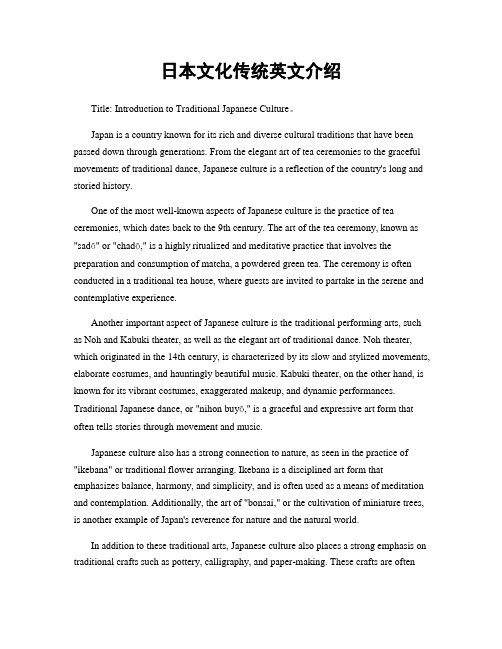
日本文化传统英文介绍Title: Introduction to Traditional Japanese Culture。
Japan is a country known for its rich and diverse cultural traditions that have been passed down through generations. From the elegant art of tea ceremonies to the graceful movements of traditional dance, Japanese culture is a reflection of the country's long and storied history.One of the most well-known aspects of Japanese culture is the practice of tea ceremonies, which dates back to the 9th century. The art of the tea ceremony, known as "sadō" or "chadō," is a highly ritualized and meditative practice that involves the preparation and consumption of matcha, a powdered green tea. The ceremony is often conducted in a traditional tea house, where guests are invited to partake in the serene and contemplative experience.Another important aspect of Japanese culture is the traditional performing arts, such as Noh and Kabuki theater, as well as the elegant art of traditional dance. Noh theater, which originated in the 14th century, is characterized by its slow and stylized movements, elaborate costumes, and hauntingly beautiful music. Kabuki theater, on the other hand, is known for its vibrant costumes, exaggerated makeup, and dynamic performances. Traditional Japanese dance, or "nihon buyō," is a graceful and expressive art form that often tells stories through movement and music.Japanese culture also has a strong connection to nature, as seen in the practice of "ikebana" or traditional flower arranging. Ikebana is a disciplined art form that emphasizes balance, harmony, and simplicity, and is often used as a means of meditation and contemplation. Additionally, the art of "bonsai," or the cultivation of miniature trees, is another example of Japan's reverence for nature and the natural world.In addition to these traditional arts, Japanese culture also places a strong emphasis on traditional crafts such as pottery, calligraphy, and paper-making. These crafts are oftenpassed down through families and communities, and are valued for their beauty, precision, and connection to the past.Overall, traditional Japanese culture is a reflection of the country's deep respect for history, nature, and the arts. From the serene beauty of tea ceremonies to the vibrant performances of traditional theater, Japan's cultural traditions continue to inspire and captivate people around the world.。
日本饮食文化 ppt课件
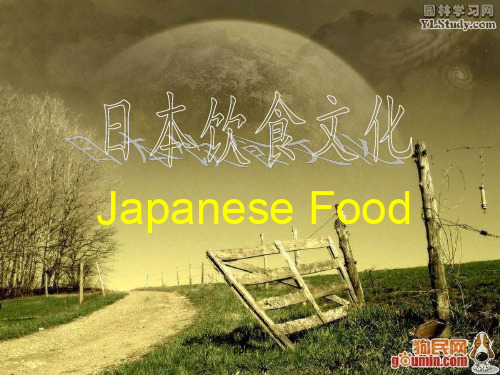
生、煮、烤、炸、蒸。而品尝日本料理的准则在于香、丰、
熟、甘、嫩。由于日本菜强调的是卖相和质感,所以每份
菜的量通常很少,但原料的素质却无与伦比。他们最强调
的是材料新鲜、刀工讲究、摆放艺术 。日本料理的种类
很多 ,比较有名的料理有:怀石料理,卓袱料理,茶会
料理,修行料理,会帮料理。
ppt课件
8
怀石料理。按照
ppt课件
6
日本人的三餐大体可归纳如下:
•
一、早餐:普通的日式早餐通常是,一个鸡蛋(50g),一碗米
饭(100g),1块烤鱼(50g)或火腿肠(50g),一盘蔬菜与水果 (150~200g),一小碟咸菜,一碗酱汤。当然也有一部分人,尤其是 年轻人,习惯于西式早餐,往往是一片面包涂上黄油或果酱,一杯牛 奶(300~400ml)或果汁、咖啡。
ppt课件
10
茶会料理。日本的室
町时代(14世纪)盛行茶道,于是出现
了茶宴茶会料理。最初的茶会料理只是
茶道的点缀,十分简单。到了室町末期,
变得非常豪华奢侈。其后,茶道创始人
千利休又恢复了茶会料理原来清淡素朴 的面目。
ppt课件
11
修行料理:修行料理又叫
“精进料理”,意思是吃斋、吃素。选料有荞 麦面、豆腐、腌菜、炸虾等。其实,所谓的
日本人喜欢食用纳豆。他们主要食用咸纳豆与拉丝纳 豆,关西人喜欢前者,关东人则爱吃后者。拉丝纳豆由于 发酵方法不同,而出现一种黏丝,是不放盐的。作。”纳 豆初始于中国的豆豉”。
ppt课件
16
ppt课件
17
• 寿司是日本传统日本食品,主要材料是用醋调味过的
冷饭(简称醋饭),再加上鱼肉、海鲜、蔬菜或鸡蛋等作 配料。既可以作为小吃也可以作正餐,花色种类繁多。配 料可以是生的、也可以是熟的,或者腌过的。
日本食文化

ご清聴ありがとう ございます
七菜一汤的菜色与顺序:
1前菜:这是最能表现出季节性的一道菜。大多是花、草 、鸟等动植物的造型 2汤:以当令的食材为主,而且一定是清汤。 3生鱼片:鱼和贝类的组合。可以欣赏红、白、黄颜色的食材组合成的图案和厨 师的刀工。 4煮蔬菜类:大多是根茎类的蔬菜。看起来虽然很朴素、简单,但是这熬蔬菜的 膏汁,是最费时费工的。可欣赏每一块蔬菜的艺术刀工。 5烤鱼或煎鱼 6炸物:主菜大多是天妇罗,有时也会以牛肉为主菜 7蒸物:土瓶或茶碗蒸 8醋味:一小钵的醋味食物,既帮助消化又爽口 9米饭,同时附上味噌汤,称为“止碗” ,意思是到此为止
食文化基本原则:以人共通的生理与心理为主轴
日式料理大多吃原味,不强调调味料,每一道菜的浓、淡、清、油都很分明, 因此上菜的顺序根据味蕾接受强烈刺激会变得钝感的原理,先生后熟、先凉 后热、先淡后浓,不然先吃了热油、味道浓的天妇罗,接着吃生鱼片,就尝 不出生鱼片清淡纤细的原味了。而中式料理的主菜可以有好几道,因此上菜 顺序几乎没有明确的规定。
まとめ
日本文化深层里有着对四季变迁的依恋。日本 人习惯用眼、耳、鼻、舌、身来感受四季及季节 的转换。日本地处季风地带,四面环海,全岛富 含大自然赋予的恩惠,却也饱受自然灾害侵袭, 因而磨练出日本人强韧的生命力。日本人善于将 四季花草融入饮食,每道料理都有其独特的品尝 方式及礼仪做法。而日本人又将这做法提至精神 文化层次。乍见繁复,却也是追求事物本质最最 踏实的方法。
怀石料理
发源自古代禅宗的僧侣一天只吃午餐和晚餐,晚上饥寒交迫时将 一些石子温热放进怀里以熬过饥寒。原本是为了暂时果腹的简素 饭菜,直到茶道鼻祖千利休结合茶道与怀石料理,定下了正式的 “茶道怀石” 的式样礼仪。怀石料理是日式料理全部礼仪和式样 的缩影。 怀石料理乍看非常简素,只有三菜一汤,但是包括山、海以及当 令的食材,量少而质高。代表着茶道的“无为” 与“禅境” 的哲 学,并且在不显眼的隐处和细部下了很大功夫,刀工、调理法、 甚至器皿的选择和摆盘都有它深层的美学和哲学依据。这就是典 型的“形而上的食物” ,吃的不是营养而是 “精神” 。
日本人的饮食文化综述

其他料理分类:
桌袱料理 茶会料理 大学料理 面食料理 修行料理 盒装冷餐御节料 理
春季茶怀石:
打破传统:创意怀石 ①出菜顺序 ②烹调
会席料理(かいせきりょうり)
晚会常见 的丰盛宴 席菜式 不拘形式
かいせきりょうり
会席料理
晚会上的丰盛宴席菜式。随着日本普通市民的社会活动 的发展,产生了料理店,形成了会席料理。会席料理可 能是以由本膳料理和怀石料理为基础简化而成的。其中 也包括各种乡土料理。会席料理通常在专门做日本菜的 饭馆里可以品尝到。 会席料理是最吻合“吃即艺术”这一名言的代表日本的 菜肴。从前菜到甜点,不论哪道菜,都不仅采用最新鲜 的食品材料,而且用最精美的形式装盛,这便是会席料 理最大的特征。会席料理,顾名思义,即令人与人通过 饮酒而相会的菜肴。日语里有发音相同的怀石料理(同 为かいせきりょうり),常常令人混淆。
会席料理
场景图
精进料理(しょうじんりょうり)
是一种斋饭。 只用豆制品、蔬菜和海苔等植物性食品做 成菜肴。 利用精进料理治疗慢性疑难病症的热潮也 在悄然兴起。 精进料理的极意被认为“由无生有”。需 要制作功夫和独特的创意。 一切都是从“心”出发,这和禅心是一脉 相同的。
精进料理的内容
日本料理特点
四季分明 讲究时令 加工精细,讲求美感,追求艺术性 拼摆别致 极工盛器 讲究“色、形、味” 选料以海味和蔬菜 为主
日本料理
①刺身(さしみ) 生鱼片 ②天婦羅(てんぷら) ③寿司(すし) ④ラーメン 拉面
最完整英文版日本美食介绍

3.The materials of sushi benefits
The useful of the material: (1)Rice can supply the necessary nutrients the body. (2)Seaweed is not only delicious High nutritional value and can prevent and cure disease. (3)Carrots can increase the vitamin. (4)Floss is easy to digest.
Delicious
Now,What will be recommended is
some Japanese food!
The development of Japanese cuisine has been 3000 years of history
Japanese food is rela tively simple, but very nutritious
Ramen [ rɑmən] 一乐拉面 一楽ラーメン いっらく らあめん Irrakuraamen
(Japanese noodle)
Ramen
Is there anybody know what it that?
Dorayaki
• We can call it red bean cake
• Or Golden cake… oh ~Delicious~
1、put Cornstarch, eggs and water into a big bowl ,than mixing them.
2、put Ginger, green Onion, ↑, and Edible oil into the Special Pot.
最完整英文版-日本美食-介绍

Japanese sushi ['su:ʃi]
The first step: wrap some cooked rice into seaweed.
['si:wi:d] (you can also put some raw fish
or vegetables into cooked rice) The second step:
• Hello, everybody~ • My name is Japanese sushi ['su:ʃi] ! • Not only Delicious I am , • But also lovely~ • Do you agree with me >.<
About sushi benefits
1.Why we choose sweet sushi benefits. 2.The original of sushi benefits 3.The materials of sushi benefits 4.How to made it 5.The benefits of it
1.Why we choose sweet sushi benefits
2.The original of sushi benefits
sushi has a very interesting origin ,that has lasted for countries and continues to be a very popular food today.
Sushi, which comes from Japan .Sushi has a long story,now sushi is popular in china.
【全面版】英文 介绍日本文化PPT文档
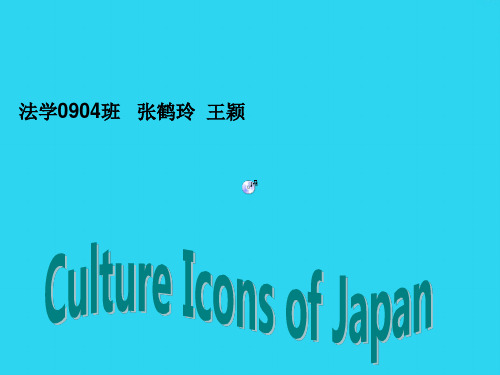
In Japanese, the cherry is called ”Sakura”, which is generally believed to be a corruption of the word “ Sakura” (blooming ) from the name of Princess KonoHana-Sakura-Hime.
There is often a misconception(误解) by some that Geisha are prostitutes(娼妓), but nothing could be further from the truth Geisha are refined and cultured girls and woman who are highly trained in a variety of traditional skills. Besides playing Shamisen ( 三弦琴), singing, and dancing, the Geisha perform the Japanese tea ceremony, and are well versed(精通的) in the art of conversation. Many learn to speak English to entertain Western guests.
This Mt. Fuji is beautiful and magic, isn’t it?
Many learn to speak English to entertain Western guests. In Japanese, the cherry is called ”Sakura”, which is generally believed to be a corruption of the word “ Sakura” (blooming ) from the name of Princess Kono-Hana-Sakura-Hime. Maneki Neko Located almost in the center of the country, this well-proportioned cone-shaped mountain has been worshiped by the Japanese people since ancient times, and is a well-known symbol of Japan in other countries. The scroll he carries bears the congenial(和蔼的) message. With a right paw raised he welcomes wealth or luck. Maneki Neko 法学0904班 张鹤玲 王颖 There is often a misconception(误解) by some that Geisha are prostitutes(娼妓), but nothing could be further from the truth Geisha are refined and cultured girls and woman who are highly trained in a variety of traditional skills. Welcoming Cat, Lucky Cat, Money cat , Fortune Cat Many learn to speak English to entertain Western guests. With economic, cultural and religious influence from neighboring Asian states, Japan has produced a unique culture of its own. 法学0904班 张鹤玲 王颖 法学0904班 张鹤玲 王颖 Located almost in the center of the country, this well-proportioned cone-shaped mountain has been worshiped by the Japanese people since ancient times, and is a well-known symbol of Japan in other countries. “Maneki Neko” means “beckoning(召唤) cat” in the Japanese language. With economic, cultural and religious influence from neighboring Asian states, Japan has produced a unique culture of its own. Fuji, however, soars into the sky alone.
Japanese food 日本食物文化
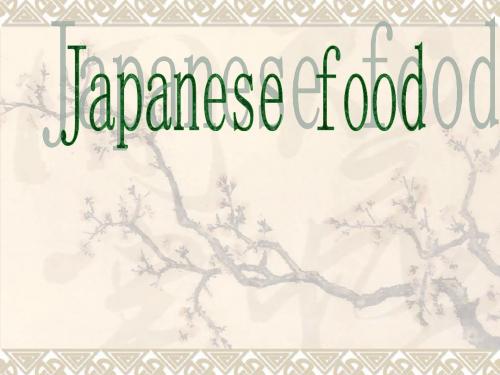
13.The 13th step is to enjoy the miso soup.(酱汤)
14.The 14th step is to have dessert.
|
INFO@
|
+12 34 567 890
|
LONG STREET 12345, CITY, COUNTRY
Hot
pot is invited by Japanese farmers. Japan has 55 kinds of hot pot.
Japanese
hot pot attaches great importance to the blood. They use clay pot. Japanese don’t have Instant-boiled mutton(涮羊肉).
Fish hot pot
Big head
Flat face
Salmonberries
Named anglerfish
Narrow tail
Ishikari-nabe石狩锅
Made by trout, mainly of its head and Salmonberries
The whole hot pot
Because the Japanese have the habitude of having supper, they always eat the whole hot pot in the first month of the lunar year.
9.The 9th step is to eat some sour soup(酸味的汤).
介绍日本传统文化-英语PPT

TIP3:THE TEA CEREMONY ETIQUETTE
Japanese Zhu product Zhu is very exquisite plac e, a were held in the room every time huan, wan g will be in the first Qian chamber activities outs ide the grid kneel down to meet the guests, the first guests into Du room must be a Cha Mu sea t guests (referred to as positive guest), the other guest barium eternal happiness down room..To attend a guest treedwelling Du things different, were sitting position is different when Du testers to send "tut" sound, said to the Lord, and Du "private. After the breeding, the rest of t he guests will be able to drink it one by one, an
LASTLY
THANKS FOR WAtraditional Japanese manners.
Terms:陈力 杨运冬 刘美阳 黄润德 熊 海福 韩国庆
TIP1:MANNERS
OF KNEEL
In Japan, the guests sit in the traditional way on their knees on the floor. Japanese girls accept etiquette education. Its strict requirements even detailed formal shoes placement, socks color and so on.
日本人饮食英文介绍作文
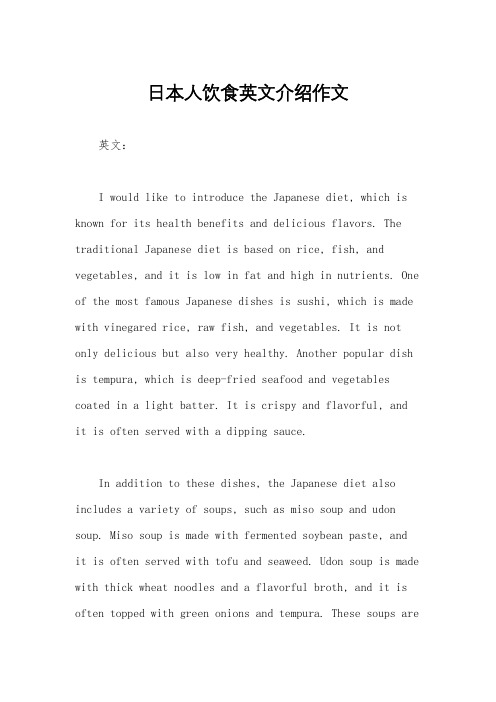
日本人饮食英文介绍作文英文:I would like to introduce the Japanese diet, which is known for its health benefits and delicious flavors. The traditional Japanese diet is based on rice, fish, and vegetables, and it is low in fat and high in nutrients. One of the most famous Japanese dishes is sushi, which is made with vinegared rice, raw fish, and vegetables. It is not only delicious but also very healthy. Another popular dish is tempura, which is deep-fried seafood and vegetables coated in a light batter. It is crispy and flavorful, and it is often served with a dipping sauce.In addition to these dishes, the Japanese diet also includes a variety of soups, such as miso soup and udon soup. Miso soup is made with fermented soybean paste, andit is often served with tofu and seaweed. Udon soup is made with thick wheat noodles and a flavorful broth, and it is often topped with green onions and tempura. These soups arenot only comforting but also very nutritious.Furthermore, the Japanese diet includes a wide varietyof pickled vegetables, such as pickled radish and pickled ginger. These pickles add a burst of flavor to any meal and are also believed to aid in digestion. Additionally, the Japanese diet includes a wide variety of seafood, such as sashimi, grilled fish, and fish roe. Seafood is a great source of protein and omega-3 fatty acids, which are essential for heart health.Overall, the Japanese diet is not only delicious but also very healthy. It is based on fresh, seasonalingredients and is prepared in a way that preserves the natural flavors of the food. I highly recommend trying Japanese cuisine if you have the opportunity.中文:我想介绍一下日本饮食,它以其健康益处和美味的口味而闻名。
日本饮食文化-PPT(精)

卓袱料理:卓袱是中
国式饭桌,即八仙桌。卓袱料理是中国式的 料理,有蘑菇、鱼糕、蔬菜的汤面、卤面等。 其特色是客人坐着靠背椅,围着一张桌子, 所有饭菜放在一张桌上。这种料理起源于我 国古代的佛门素食,由隐元禅师作为“普茶 料理”(即以茶代酒的料理)加以发扬。由 于盛行于长崎,故又称长崎料理。料理师在 佛门素食内采用了当地产的水产肉类,便创 立了卓袱料理。
“会席料理”,是最最吻合“吃即艺术”这一名
言的代表日本的菜肴。从前菜到甜点构成,不论哪道菜,都不仅采 用最最新鲜的食品材料,而且用最最精美的形式装盛,这便是“会 席料理”最大的特征。
•
日本生鱼片称为 ,一般都是用新鲜海鱼、 海贝制作,蘸以酱油、山葵等,是日本菜中接近最清淡的 菜式,也是具有代表性的菜式之一。国宴或平民请客以招 待生鱼片为最高礼节。开宴时,让你看到一缸活鱼,现捞 现杀,剥皮去刺,切成如纸的透明状薄片,端上餐桌,蘸 着佐料细细咀嚼,滋味美不可言。 生鱼片是日本料理中最有代表性最具特色的食品。江 户时代以前,生鱼片主要以鲷鱼、鲆鱼、鲽鱼、鲈鱼为材 料,这些鱼肉都是白色的。明治以后,肉呈红色的金枪鱼, 鲣鱼成了生鱼片的上等材料。现在,日本人把贝类、龙虾 等切成薄片,也叫"刺身"。其中河豚鱼是生鱼片中的佼佼 者。
• 寿司是日本传统日本食品,主要材料是用醋调味过的
冷饭(简称醋饭),再加上鱼肉、海鲜、蔬菜或鸡蛋等作 配料。既可以作为小吃也可以作正餐,花色种类繁多。配 料可以是生的、也可以是熟的,或者腌过的。 • 寿司必须的材料是米饭。正宗日式寿司用的是肥小而稍带 甜味的日本珍珠米。米饭煮熟后,加入适量的寿司醋、糖、 盐等调味,待降温后才用来制作寿司。 • 寿司分为:卷寿司,握寿司,稻荷寿司,江户前散寿司 等
日本饮食文化介绍(英文ppt)ppt

---Group Members:Kang Yao Liu Jianqiang Cao Peiyu He Yi
-
• The staple of the Japanese diet is rice.Rice and miso soup has been common breakfast foods. There are also many people who eat Mbisroesaoudp for breakfast.
-
Buckwheat Noodles
-
Байду номын сангаас
Buckwheat Noodles
-
4:Sushi
• In Japanese cuisine, sushi is vinegared rice, usually topped with other ingredients, including fish, various meats, and vegetables. Funa sushi
-
2:Sukiyaki
• Sukiyaki is one of the representative foods of Japan. The name comes from the farmer’ spade sometimes used to cook on. Sukiyaki refers directly to broiling on the spade, along with soybean curd, leeks, and vegetables. The seasoning includes soy sauce , sweet sake, and sugar.
Japanese food 日本食物文化

13.The 13th step is to enjoy the miso soup.(酱汤)
14.The 14th step is to have dessert.
Soba is made from buckwheat flour.It's thin, light brown, tastes very good. Udon noodles is made from wheat flour, usually in cream-colored.The noodles is very thick. Somen is also made from flour, but thin as hair. Udon noodles are usually cooked into hot noddles, buckwheat and plain can be cooked either hot or cold, which mainly depends on the season.
11
somen (素面)
12
Soba日语:そば 或 荞麦切り
Cold soba is mainly eaten in summer,such as Skimmer soba「ざ るそば」(笊篱荞 麦面),Steamer sobaもりそば」 (蒸笼荞麦 面).People who prefer the hot one would like soup noodles「かけそば」 (清汤荞麦面)
(怀石料理)
Kaiseki was the food shared with the guests by the host in Japanese tea ceremony in the past . And now it is one of the Janpanese common high-end dishes . Kaiseki is a extremely delicate dish, the placing of tableware and food has high requirements but there is few food .So,it's seen as a work of art by someone. And the high-grade kaiseki is very expensive .
日本餐饮文化日语作文英语

日本餐饮文化日语作文英语Japanese Food Culture。
Japan is famous for its unique and delicious cuisine. Japanese food is not only tasty but also healthy, and ithas become popular all over the world. In this essay, wewill explore the Japanese food culture and its significance.One of the most popular Japanese dishes is sushi. Sushi is made of rice and raw fish, and it is often served with soy sauce and wasabi. Sushi is not only delicious but also healthy, as it contains a lot of vitamins and minerals. Sushi is a traditional dish in Japan, and it has become popular all over the world.Another popular Japanese dish is ramen. Ramen is a noodle dish that is served in a soup broth. The soup brothis made of pork or chicken bones, and it is often flavored with soy sauce or miso. Ramen is a popular fast food in Japan, and it is often eaten in restaurants or food stalls.In addition to sushi and ramen, Japanese cuisine also includes other dishes such as tempura, udon, and yakitori. Tempura is a dish of battered and deep-fried seafood or vegetables. Udon is a thick noodle dish that is oftenserved in a soup broth. Yakitori is a skewered and grilled chicken dish that is often served with a sweet soy sauce.Japanese food culture is not only about the dishes themselves but also about the way they are presented and served. Japanese food is often served in small portions,and it is presented in a beautiful and artistic way. The presentation of the food is as important as the taste, andit is often said that people eat with their eyes first.In Japan, food is also an important part of socializing. People often gather with friends and family to enjoy a meal together. In addition, there are many festivals and eventsin Japan that are centered around food, such as the Cherry Blossom Festival and the Sapporo Snow Festival.In conclusion, Japanese food culture is unique andsignificant. Japanese cuisine is not only delicious but also healthy, and it has become popular all over the world. The presentation of the food is as important as the taste, and food is an important part of socializing in Japan. If you have the opportunity to try Japanese food, do not hesitate to do so, as it is truly a culinary experience.。
日本文化介绍(全英文版)
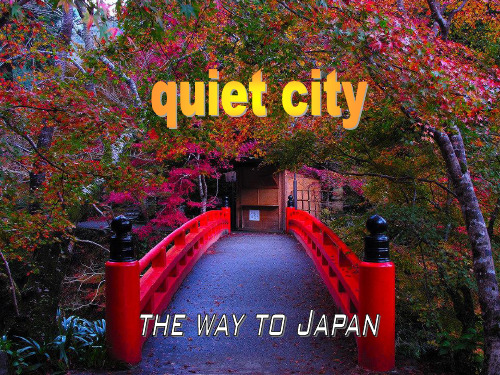
Composition
• The main islands, sometimes called the "Home Islands", are (from north to south) Hokkaidō, Honshū (the "mainland"), Shikoku and Kyūshū. There are also about 3,000 smaller islands, including Okinawa, and islets, some inhabited and others uninhabited. In total, as of 2006, Japan's territory is 377,923.1 km² , of which 374,834 km²is land and 3,091 km²water. This makes Japan's total area slightly smaller than the U.S. state of Montana, slightly bigger than the Brazilian state of Mato Grosso do Sul. Japan is bigger than Germany, Malaysia, New Zealand and the U.K., and is 1.7 times the (和服)
The kimono is a Japanese traditional garment worn by women, men and children. The word "kimono", which literally means a "thing to wear" (ki "wear" and mono "thing"), has come to denote these full-length robes. The standard plural of the word kimono in English is kimonos,[but the unmarked Japanese plural kimono is also sometimes used. Kimono are T-shaped, straight-lined robes worn so that the hem falls to the ankle, with attached collars and long, wide sleeves. Kimono are wrapped around the body, always with the left side over the right (except when dressing the dead for burial),[and secured by a sash called an obi, which is tied at the back. Kimono are generally worn with traditional footwear and split-toe socksToday, kimono are most often worn by women, and on special occasions. Traditionally, unmarried women wore a style of kimono called furisodewith almost floor-length sleeves, on special occasions. A few older women and even fewer men still wear the kimono on a daily basis. Men wear the kimono most often at weddings, tea ceremonies, and other very special or very formal occasions. Professional sumo wrestlers are often seen in the kimono because they are required to wear traditional Japanese dress whenever appearing in public
日本美食介绍【英文ppt】

Ebi nigiri sushi (海老握り) Eel sushi (鰻寿 司) Salmon Sushi(鮭握り)
Fatty tuna belly sushi (鮪とろ握 り)
Ikura gunkanmaki (イクラ軍 艦巻き)
Wagashi
——和菓子
Wagashi is a traditional Japanese confectionery which is often served with tea, especially the types made of mochi, anko, and fruits. Wagashi is typically made from plant
JAPANESE FOOD
Ramen
卵かけご飯
うなぎ丼
桜餅
tempura
SUSHI
——すし
Sushi is a Japanese food consisting of cooked vinegared rice combined with other ingredients, seafood, vegetables and sometimes tropical fruits. Ingredients and forms of sushi presentation vary wide all sushi have in common
——Thanks
——ありがとう
Mochi
——麻糬
A rice cake made of glutinous rice
Dango
——丸子
a small, sticky, sweet mochi, commonly skewered on a stick
日本饮食英语作文
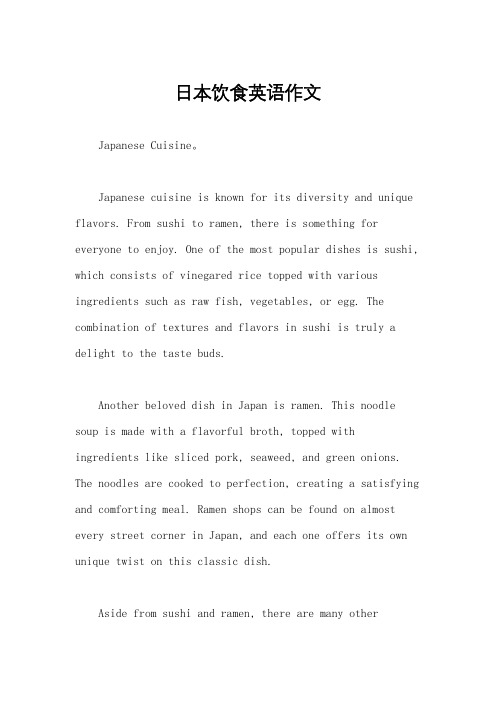
日本饮食英语作文Japanese Cuisine。
Japanese cuisine is known for its diversity and unique flavors. From sushi to ramen, there is something for everyone to enjoy. One of the most popular dishes is sushi, which consists of vinegared rice topped with various ingredients such as raw fish, vegetables, or egg. The combination of textures and flavors in sushi is truly a delight to the taste buds.Another beloved dish in Japan is ramen. This noodle soup is made with a flavorful broth, topped with ingredients like sliced pork, seaweed, and green onions. The noodles are cooked to perfection, creating a satisfying and comforting meal. Ramen shops can be found on almost every street corner in Japan, and each one offers its own unique twist on this classic dish.Aside from sushi and ramen, there are many othertraditional Japanese dishes that are worth trying. Tempura is a popular dish consisting of battered and deep-fried seafood or vegetables. The light and crispy texture of the batter combined with the freshness of the ingredients is simply delicious. Another dish that shouldn't be missed is yakitori, which is skewered and grilled chicken. The smoky flavor and tender meat make it a favorite among locals and tourists alike.Japanese cuisine also includes a wide variety of street foods. Takoyaki, for example, is a popular snack made of batter filled with diced octopus, green onion, and tempura scraps. These bite-sized balls are cooked on a special griddle and topped with savory sauce, mayonnaise, and bonito flakes. It's a must-try for anyone visiting Japan.In addition to the diverse range of dishes, Japanese cuisine is also known for its emphasis on presentation. The meticulous arrangement of ingredients and attention to detail make each dish a work of art. From the delicate placement of sashimi on a plate to the vibrant colors of a bento box, Japanese cuisine is as visually appealing as itis delicious.Overall, Japanese cuisine offers a unique and unforgettable dining experience. Whether you're a fan of sushi, ramen, or street food, there is something for everyone to enjoy. The flavors, textures, and presentation of Japanese dishes are truly remarkable. So next time you have the opportunity, be sure to indulge in the culinary delights of Japan.。
- 1、下载文档前请自行甄别文档内容的完整性,平台不提供额外的编辑、内容补充、找答案等附加服务。
- 2、"仅部分预览"的文档,不可在线预览部分如存在完整性等问题,可反馈申请退款(可完整预览的文档不适用该条件!)。
- 3、如文档侵犯您的权益,请联系客服反馈,我们会尽快为您处理(人工客服工作时间:9:00-18:30)。
3Buckwheat ['bʌkwi:t] noodles荞麦 面条
• Buckwheat noodles or soba is also a typical Japanese dish. There are some people that eat soba at least once a day. Many office workers make it a habit to have soba for lunch. Soba noodles are a mixture of buckwheat, flour ['flauə] 面粉and eggs. It looks similar to spaghetti in shape. It is first boiled, and then dipped in a soup made of soy sauce, salt, sweet sake, and bonito[bə'ni:təu] shavings when it is being eaten. Because soba is long, it is considered a symbol of long life.
First:Tempura「tem'purə」天妇罗
1:Tempura「tem'purə」天妇罗
• This dish mostly consists of deep-fried eggplant, squash[skwɔʃ], sweet potato, and other vegetables, along with shrimp [ʃrimp] 小虾and Fish. One theory is that the word tempura came from the Spanish tempera, meaning temperature. Tempura is eaten with a special soy saucebased dip. 天妇罗主要是茄子、南瓜、甘薯等菜 类以及虾、鱼等的油炸食品。有一种说法认为 “天妇罗”的语源是西班牙语“tempera(温 度)”。吃天妇罗时要蘸着一种特制的油,这种 油的主要成'jɑ:ki:] 鸡素烧
• Sukiyaki is one of the representative foods of Japan. The name comes from the farmer’ spade sometimes used to cook on. Sukiyaki refers directly to broiling beef on the spade, along with soybean curd, leeks, and vegetables. The seasoning 调料includes soy sauce [sɔ:s], sweet sake, and sugar.
Japanese Food—by Tom
• The staple [‘steipl] 主食of the Japanese diet is rice, rice and soybean curd soup酱 汤being common breakfast foods. There are also many people who eat bread for breakfast. • Japanese food mostly consists of fish instead of meat, and also soybeans, so it is good for the health. Foods that are most well received by foreigners are tempura 「tem'purə」天妇罗, sukiyaki [suki:'jɑ:ki:] 鸡素烧, sushi ['su:ʃi:] 寿司, sashimi [sɑ:'ʃi:mi]生鱼片, buckwheat noodles荞麦 面条, and soybean curd.
